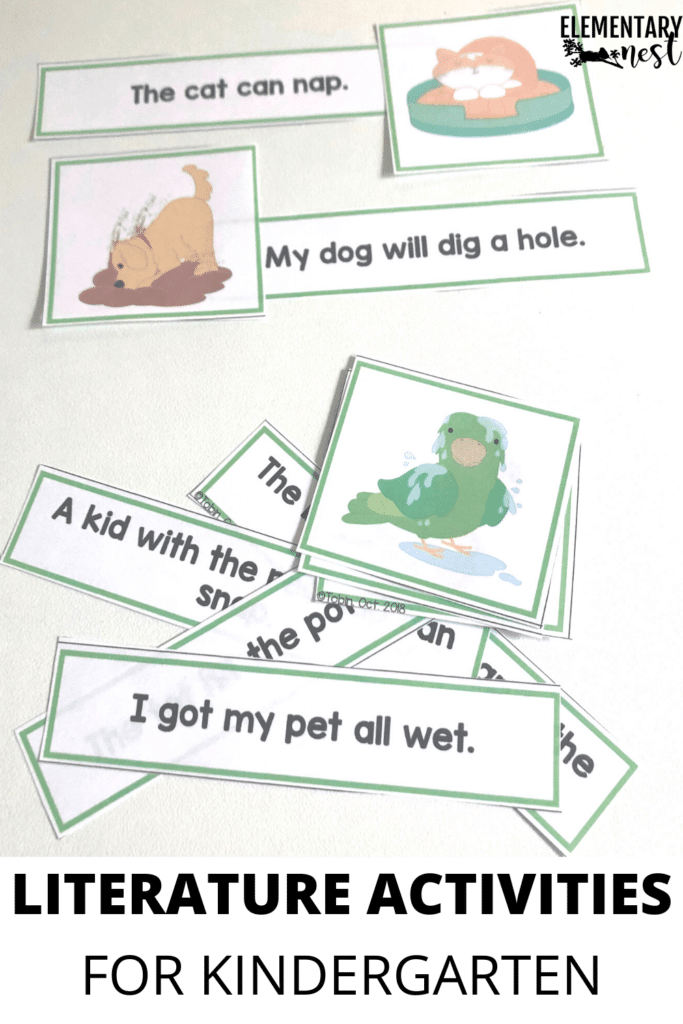
This blog post focuses on teaching Kindergarten literature skills. These skills are key for students to master as they begin to think critically about different types of text. These literature skills will build a strong foundation for literature skills to come. The resources referenced in this blog post all align with a common core Kindergarten literature standard.
Kindergarten Literature Standards:
- RL.K.1: With prompting and support, ask and answer questions about key details in a text.
- RL.K.2: With prompting and support, retell familiar stories, including key details.
- RL.K.3: With prompting and support, identify characters, settings, and major events in a story.
- RL.K.4: Ask and answer questions about unknown words in a text.
- RL.K.5: Recognize common types of texts (e.g., storybooks, poems).
- RL.K.6: With prompting and support, name the author and illustrator of a story and define the role of each in telling the story.
- RL.K.7: With prompting and support, describe the relationship between illustrations and the story in which they appear (e.g., what moment in a story an illustration depicts).
- RL.K.9: With prompting and support, compare and contrast the adventures and experiences of characters in familiar stories.
What We Will Learn In This Blog Post:
- Outline your year
- Start simple
- Teach them to rely on illustrations
- Teacher-led importance
- Model everything
- Introduce more and more types of text over time
Outline Your Year with Literature Standards
When planning out your Kindergarten ELA lessons, it is helpful to outline the year so you can properly pace your instruction. This helps you plan your units and lessons in a way that flows nicely and allows your students to build on prior knowledge. Subsequently, it ensures that you are teaching all of the standards that you need to.
To help you outline your year, I have created a free pacing guide to help map out your instruction and plan for your literature standards. This pacing guide outlines all six Kindergarten ELA domains and links to my resources for each. If your school already has a pacing guide, feel free to use this as a reference and to use the resources included where you see fit.
(Link: Free Pacing Guide)
Start Year with Simpler Standards
At the beginning of the school year, your students are still learning letter names/sounds, basic decoding skills, and CVC words. It is important that you start the year focusing on those basic reading skills. Moving too quickly through your ELA standards will cause gaps and students will not reach mastery of those beginning skills. As the year goes on, move into the tougher standards as your students master the simpler standards.

Source: RLK.1
One of the first Kindergarten literature skills that you will teach is to ask and answer questions about key details in text. Students may begin doing this with illustrations, read alouds, and short stories. This resource includes many activities and ideas for teaching this standard.
Focus on the Importance of Illustrations

Source: RLK.5
It is good practice when teaching these Kindergarten literature skills to teach students about the importance of illustrations in the text. Using picture clues will help them determine the type of text, answer questions about the text, etc. Analyzing the illustrations will also help develop critical thinking skills.

Source: RLK.7
This simple sentence and illustration matching game is a great activity to encourage students to analyze the picture and match it to the sentence that makes the most sense. Not only are they working on an important Kindergarten literature skill, but they are also applying those beginning reading skills, such as reading sight words and decoding CVC words.
Wordless Books are Beneficial

Source: RLK.7
When teaching the Kindergarten literature skill about illustrations, wordless story routines are effective. They allow students to focus on the story and relationship between the illustrations and the story instead of the basic reading skills. It also encourages them to use their imagination and logic to determine what is happening in the story.
Here are a few Amazon affiliate links to wordless books your kiddos will love.
Make Standards-Based Activities All Teacher-Led

Source: RLK.1
Activities, lessons, and passages that are standards-based are best presented in a teacher-led manner. They are critical standards, thus, it is best that the teacher can lead the students by guiding them in the right direction and modeling how to ask and answer questions effectively. As the students develop these literature skills, the teacher can start scaffolding instruction.

Source: RLK.7
Due to the complexity of these Kindergarten literature skills, all reading passages and books should be done in a whole group or small group setting with teacher guidance. Consequently, the teacher will be able to pause for discussion and ensure that all students are understanding the skill and applying it in an effective manner.
Model Everything

Source: RLK.7
Since there are several Kindergarten literature skills, it is important that the teacher models how to focus on a given skill while reading. For example, this activity focuses on analyzing the illustrations along with the reading skill to determine what is happening in the story. Modeling how to use the illustrations to make sense of the story is a key skill, but requires modeling before the students can do this independently.
Teach Different Types of Text

Source: RLK.5
One of the Kindergarten literature skills is recognizing different types of text. Teaching students about these text forms, such as poems, fiction, nonfiction, drama, story, etc., is crucial. This skill is complex, as there are many different types of text. This resource provides several different activities and strategies for helping students master this skill. These visual text cards are perfect for showing the difference in texts.
Suggested Resources to Make Teaching Literature Skills Simple
If you’d prefer to have single sets (not the bundle) there are individual links to purchase single sets within the bundle link above!
Download a FREE lesson plan for kindergarten.
Want more blog posts all about Literature Standards?




















